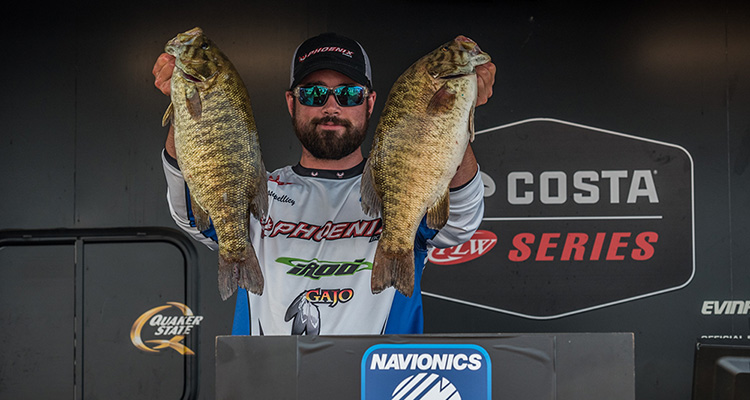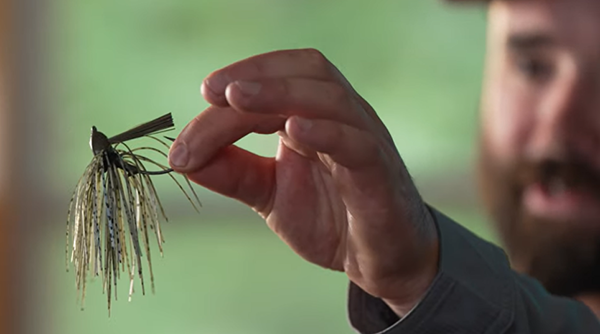Hooked on Bass
Jesse Spellicy’s Journey into Tournament Fishing
by PJ DelHomme
The host of our latest SMART Tips & Tricks: Pro Advice for All Anglers video series shares his expertise on how you can catch more fish along with some insight into tournament fishing.
Born and raised in the Northeast, 31-year-old Jesse Spellicy has a knack for busting big bass. And it’s a passion that started early. “I would fish with whoever would take me,” he recalls. “My dad was outdoorsy, but he wasn’t a fisherman per se. My dad’s buddies had a little john boat, and it boiled down to me begging people to take me fishing.” This early enthusiasm has since evolved into a lifelong pursuit, with fishing still a big part of his life.
Today, he balances Bassmaster Tournaments with a full-time job as a John Deere heavy equipment salesman and being a dad to two little girls (eight and one). So, we were thrilled when our video producer Jamieson Crast tracked him down to shoot some videos with us. Before we get into those videos, we thought it might be fun to understand how someone gets into the seemingly whimsical world of tournament fishing. As it turns out, it might not be as cool as it sounds.
The Challenges of Tournament Fishing
Spellicy’s first tournament experience came at the age of 15, in what he describes as a casual local event where “dudes get together and throw 20 bucks in the hat, and the heaviest fish wins.” From these beginnings, he gradually worked his way up to more challenging competitions.
In 2019, he pursued his dream of making fishing a full-time career, which proved a catch-22. He was on Lake Chickamauga in Tennessee at the Bassmaster Open. He describes these opens as “bass fishing purgatory” but a crucial stepping stone to the elite levels of competitive fishing.
“The first day of that tournament, I was in 180th place. Then on day two, I was on the water trying to figure out where to go, and I pulled my phone out, looked at Google Earth, and spotted a small little bay.”
Taking a risk, he made an hour-long boat ride to the new spot. “It was the middle of May in Tennessee. I rolled up to the first spot, pulled out a topwater walking bait, and caught the biggest limit of fish weighed in on the second day.” He moved into 19th place and bolstered confidence in his instincts.

Jesse Spellicy at weigh-in
And it’s that challenge that’s attractive to him. “The most challenging thing is that the conditions are always changing, and different conditions put the fish in different moods,” he explains. Success in this field requires more than just luck or innate skill. “Time on the water is the number one key to knowing fish.”
That season also proved to be a gut check. “It made me realize it isn’t a lifestyle I wanted to live. By being gone so much, I would miss out on everything. Birthdays, holidays. I would be on the road from January through September.”
Plus, it’s not exactly cheap. “Some of these tournaments cost $2,000 to enter. If you don’t do well, that makes a long miserable drive home.”
He still competes today, but more time on the water is spent with his oldest daughter, a junior Bassmaster. “Fishing is something we can do one-on-one,” he says. “It’s a good way to spend time with them. We can talk about nature one minute and look at a loon, wondering where they go in the winter. And then we immediately start talking about some new makeup on YouTube.”
#1 Lure and the Rise of Tech
Every angler has a favorite lure, and for Spellicy, it’s the weedless jig. “It’s the most versatile,” he says. “And I feel like it catches a little bit better than average fish. It’s the one lure that I can throw 365 days from Florida to Maine.”

Jesse Spellicy’s #1 lure – the weedless jig.
While jigs are hardly new technology, there are plenty of gadgets today to find fish—and they’re almost too good. Since Spellicy started seriously fishing about 16 years ago, he says the tech has changed incredibly. “The rod and reel tackle hasn’t changed much. But the cell phones, depth finders, some of the accessories on the boats, with GPS trolling motors that will hold you in a certain spot, are wild,” he says. No discussion about fishing tech would be complete without the controversial topic of forward-facing sonar. “With that tech, you can see out to 120 feet in front of the boat and see fish swimming in real time. And watch that lure.” This kind of thing was unheard of when he first started competing.
As for anglers who like fishing and want to enter a tournament, Spellicy recommends starting local. “Search for a local bass club and reach out to the local director. The bass fishing community can be intimidating, but most are welcoming. Just a quick internet search will do the trick.”
SMART Tips & Tricks: Pro Advice for All Anglers
Produced in collaboration with his friend (and ours), Jamieson Crast, these short videos cover essential topics for anglers of all levels, distilling years of on-the-water experience into easily digestible videos. See for yourself.
- Top 5 Baits You Need in Your Tackle Box
- What Color Lure and Why
- Two Main Rod & Reel Combinations
Special thanks to the following sponsors for making this video series possible:
International Brotherhood of Electrical Workers (IBEW)
National Electrical Contractors Association (NECA)
United Association/International Training Fund’s Veterans in Piping Program (VIP)
Ullico
International Association of Sheet Metal, Air, Rail and Transportation Workers (SMART)
PJ DelHomme writes and edits content from western Montana. He runs Crazy Canyon Media and Crazy Canyon Journal.





